Starbucks Bundle
Can Starbucks Maintain Its Coffee Empire in a Changing World?
Starbucks, the global coffee giant, isn't just selling coffee; it's crafting an experience. From its humble beginnings, the company has become a cultural icon, transforming how we consume and perceive coffee. But in a market brimming with rivals, how does Starbucks navigate the Starbucks SWOT Analysis and maintain its dominance?
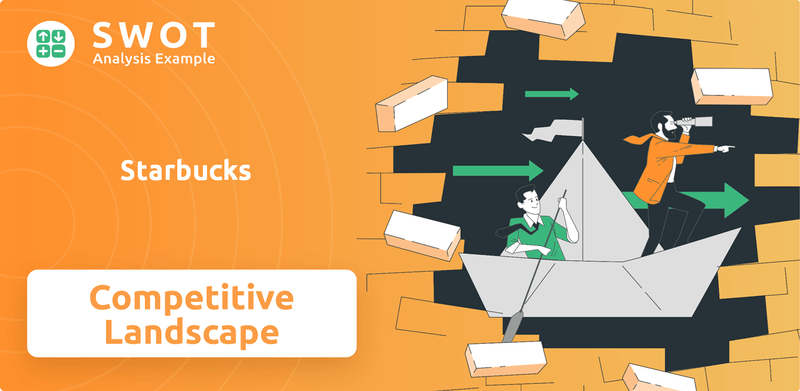
This exploration into the Starbucks competitive landscape will dissect the strategies that have fueled its success, considering the Starbucks competitors and the evolving coffee industry trends. We'll analyze Starbucks' business model, its response to emerging competitors, and its long-term vision. Understanding Starbucks competition is crucial for investors and business strategists alike.
Where Does Starbucks’ Stand in the Current Market?
The company maintains a strong market position in the global coffee industry, largely due to its extensive global presence and brand recognition. The company's financial performance is significant, with net revenues reaching $36.0 billion in 2023. Starbucks' primary offerings include a diverse range of hot and cold coffee beverages, espresso drinks, teas, and various food items.
Starbucks has strategically evolved its positioning over time. Initially known for premium coffee, it has diversified its offerings and adapted to various market segments. This includes introducing more affordable options and expanding ready-to-drink (RTD) product lines. The company's digital initiatives, such as its mobile order and pay system and loyalty programs, are crucial for enhancing customer convenience and engagement.
The company's geographic footprint is vast, with a strong presence in North America, particularly the United States, and growing expansion in international markets like China and the Asia Pacific region. Starbucks primarily serves a broad customer base, including daily commuters and individuals seeking a 'third place' experience. For more insight into the customer base, you can read about the Target Market of Starbucks.
The company operates primarily as a roaster and retailer of specialty coffee, tea, and related products. It manages a vast network of company-operated stores and licensed stores globally. The core operations involve sourcing high-quality coffee beans, roasting them, and preparing beverages and food items for customers.
The value proposition centers on providing a premium coffee experience and a welcoming environment. It offers a wide variety of high-quality coffee beverages, food, and merchandise. The company's focus on customer experience, convenience through digital channels, and its "third place" concept differentiate it from competitors.
The company consistently ranks as a leading coffeehouse chain by number of stores and revenue globally. While specific market share figures vary by region and are dynamic, the company maintains a significant share in the coffee shop market. The company's strong brand recognition and extensive global footprint support its market share.
The company demonstrates robust financial performance, often exceeding industry averages in revenue growth and profitability. In Q1 2024, consolidated net revenues were reported at $9.4 billion. The company's financial health is supported by its strong brand, global presence, and effective business model.
The company faces a competitive landscape shaped by both global and local coffee chains, as well as independent coffee shops. Starbucks' strategies include product innovation, digital initiatives, and global expansion. The company's ability to adapt to changing consumer preferences and maintain a strong brand reputation is crucial.
- The company's competitive advantages include brand recognition, global presence, and a strong loyalty program.
- Challenges include competition from other coffee chains and emerging market dynamics.
- The company's digital transformation, including mobile ordering and loyalty programs, enhances customer convenience.
- Sustainability initiatives and ethical sourcing are increasingly important for competitive positioning.
Starbucks SWOT Analysis
- Complete SWOT Breakdown
- Fully Customizable
- Editable in Excel & Word
- Professional Formatting
- Investor-Ready Format
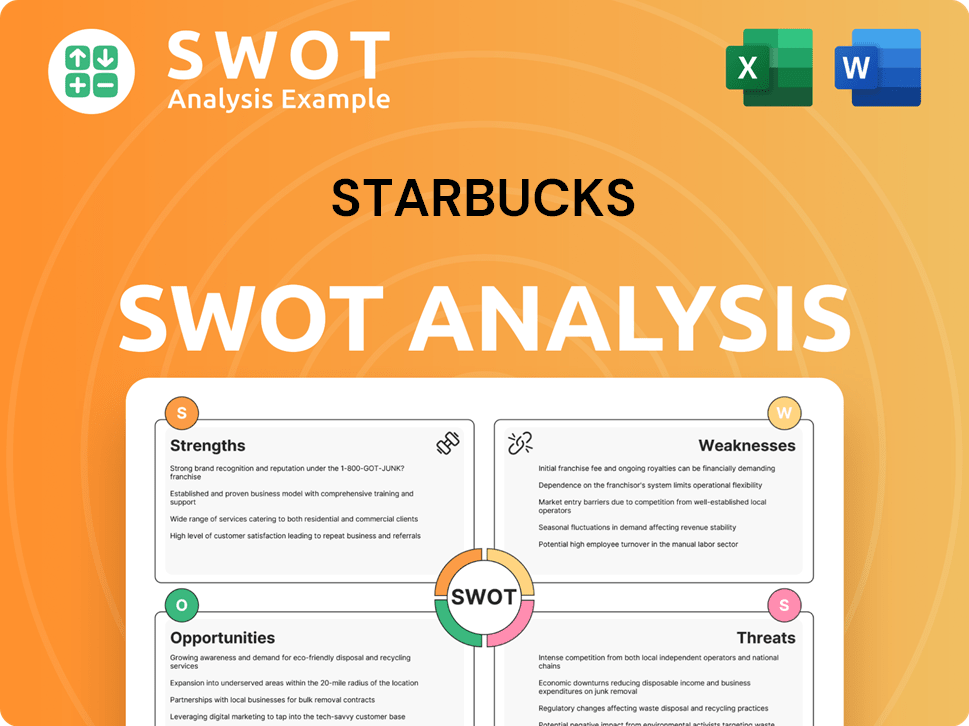
Who Are the Main Competitors Challenging Starbucks?
The Starbucks competitive landscape is characterized by intense competition from a variety of sources, including large coffeehouse chains, fast-food restaurants, and independent coffee shops. This dynamic environment requires constant adaptation and innovation to maintain market share and profitability. Understanding the Starbucks market analysis and the strategies of its rivals is crucial for assessing its future prospects.
Starbucks' business model faces challenges from both direct and indirect competitors. Direct competitors vie for the same customer base, offering similar products and services, while indirect competitors provide alternative solutions that satisfy the same consumer needs. This multifaceted competition necessitates a comprehensive understanding of the Starbucks competitors and the broader coffee industry trends.
Starbucks competition is a complex interplay of various factors, including pricing, convenience, product offerings, and brand loyalty. Analyzing these factors provides insights into the Starbucks competitive advantages and disadvantages, which is essential for making informed investment decisions and developing effective business strategies.
Direct competitors include major coffeehouse chains, fast-food establishments, and independent coffee shops. These rivals directly challenge Starbucks' market share compared to competitors by offering similar products and services.
McDonald's, through its McCafé offerings, competes strongly on price and convenience. They leverage their extensive drive-thru network to attract customers seeking quick coffee solutions. In 2023, McDonald's global revenue reached approximately $25.4 billion, a portion of which is attributed to McCafé sales.
Dunkin' is a significant direct competitor, particularly in the Eastern United States. Known for its extensive menu and focus on speed and affordability. Dunkin' Brands' system-wide sales in 2023 were around $14.8 billion.
Tim Hortons, especially strong in Canada, poses a significant competitive threat in its regions. They focus on coffee, baked goods, and breakfast items. In 2023, Tim Hortons' parent company, Restaurant Brands International (RBI), reported system-wide sales of approximately $40 billion.
A multitude of smaller, independent coffee shops and local chains provide a differentiated experience, often focusing on artisanal coffee, unique ambiance, or community engagement. These establishments challenge Starbucks' strategies to maintain market leadership at a local level.
Indirect competitors include grocery stores, convenience stores, and at-home coffee solutions. These competitors offer alternative ways for consumers to satisfy their coffee needs. The rise of specialty coffee roasters and direct-to-consumer online coffee sales also presents a growing challenge.
The competitive landscape is shaped by new product introductions, pricing strategies, and loyalty program enhancements. The ongoing competition for morning commuters between Starbucks, McDonald's, and Dunkin' highlights the intense rivalry. Furthermore, mergers and acquisitions significantly reshape the competitive dynamics.
- Pricing Strategy: Starbucks' pricing strategy compared to competitors often involves premium pricing, reflecting its brand image and perceived value. However, competitors like McDonald's and Dunkin' focus on value pricing to attract price-sensitive consumers.
- Product Innovation: Starbucks continuously introduces new products and seasonal offerings to maintain consumer interest. Competitors also innovate, with McDonald's expanding its McCafé menu and Dunkin' focusing on unique coffee flavors and food pairings.
- Loyalty Programs: Starbucks' loyalty program and its impact on competition is a key strategy. Competitors also offer loyalty programs to retain customers. For example, Dunkin' has its DD Perks program, offering rewards and personalized offers.
- Technology and Convenience: How Starbucks uses technology to compete includes mobile ordering, delivery services, and digital rewards. Competitors are also investing in technology to improve convenience.
- Global Expansion: Starbucks' global expansion and competitive challenges involve navigating diverse markets and adapting to local preferences. Competitors such as McDonald's and Tim Hortons also have significant international presence.
Understanding the competitive landscape is critical for assessing the future of the company. To learn more about the company's strategies, consider reading about the Growth Strategy of Starbucks.
Starbucks PESTLE Analysis
- Covers All 6 PESTLE Categories
- No Research Needed – Save Hours of Work
- Built by Experts, Trusted by Consultants
- Instant Download, Ready to Use
- 100% Editable, Fully Customizable
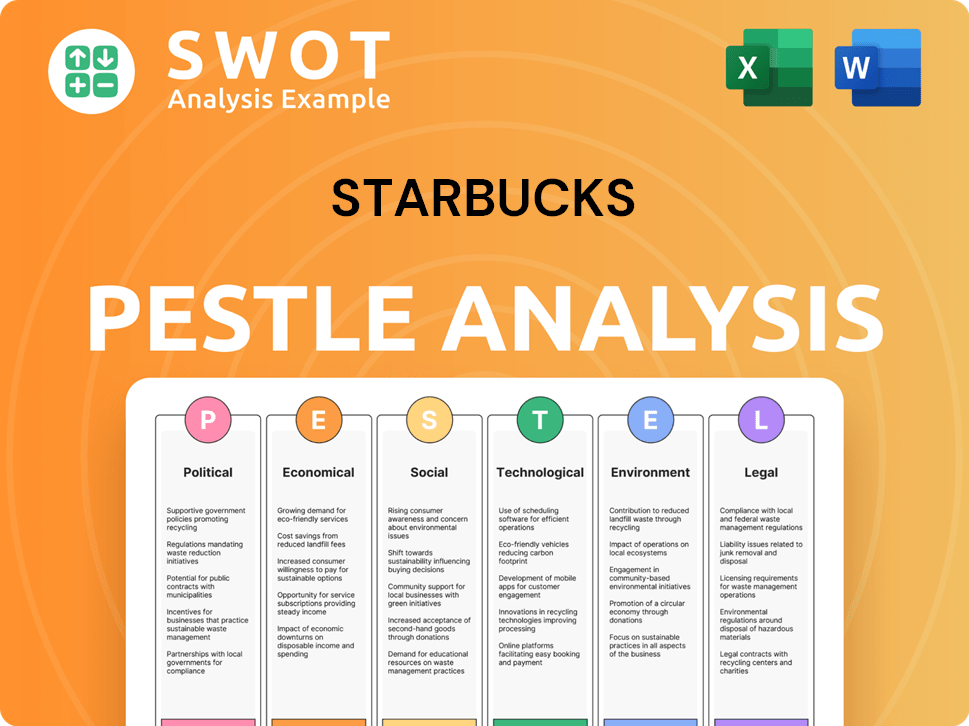
What Gives Starbucks a Competitive Edge Over Its Rivals?
The competitive landscape for the coffee industry is dynamic, and understanding the Starbucks competition is crucial for any market analysis. The company has established a strong foothold, but faces ongoing challenges and opportunities. Analyzing Starbucks' competitive landscape involves examining its strategies, market position, and responses to evolving consumer preferences and coffee industry trends.
Starbucks' business model has been a key factor in its success, focusing on creating a 'third place' experience alongside high-quality coffee. This approach has allowed it to differentiate itself from competitors and build a loyal customer base. The company's ability to adapt to changing market dynamics and leverage technology further shapes its competitive advantages.
The company's enduring success is underpinned by several core competitive advantages that differentiate it from rivals. Foremost among these is its unparalleled brand equity and global recognition. The logo is instantly recognizable worldwide, symbolizing a consistent, premium coffee experience. This strong brand fosters immense customer loyalty, driven in part by its highly successful rewards program, which boasts millions of active members and incentivizes repeat purchases through personalized offers and rewards.
The brand's global presence and consistent quality contribute to its strong market position. The company's brand recognition is a significant competitive advantage. This recognition translates into customer loyalty and a willingness to pay a premium.
With over 38,000 stores across 84 markets, accessibility is a key advantage. This extensive network ensures widespread availability and convenience for consumers. It is a scale that is difficult for most competitors to replicate.
The rewards program encourages repeat purchases and provides valuable data. The program offers personalized offers and rewards, fostering customer engagement. This loyalty program also provides valuable data for understanding consumer preferences.
The mobile app enhances customer convenience and engagement. It facilitates order and pay, personalization, and loyalty integration. This technological edge improves the overall customer experience.
Several factors contribute to the company's sustained success and its ability to maintain market leadership. These include its strong brand, global scale, customer loyalty, and technological integration. These elements create a sustainable competitive moat, making it challenging for rivals to gain significant ground.
- Brand Strength: The instantly recognizable brand and premium image.
- Global Scale: An extensive network providing widespread accessibility.
- Customer Loyalty: The rewards program that fosters repeat purchases.
- Technological Innovation: Mobile app and digital initiatives that enhance customer experience.
Starbucks Business Model Canvas
- Complete 9-Block Business Model Canvas
- Effortlessly Communicate Your Business Strategy
- Investor-Ready BMC Format
- 100% Editable and Customizable
- Clear and Structured Layout
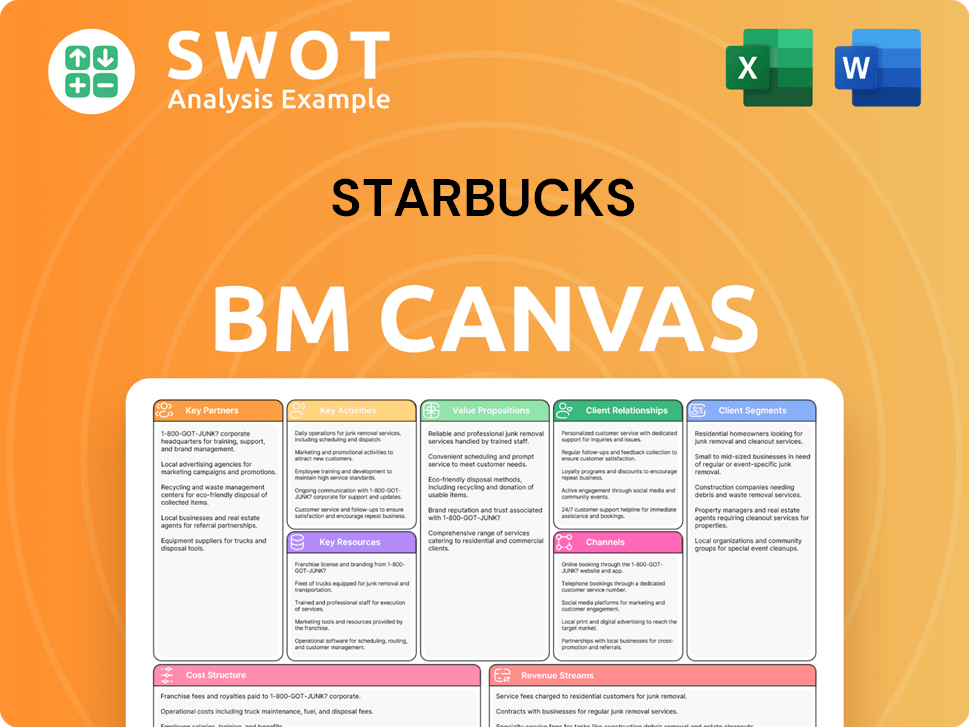
What Industry Trends Are Reshaping Starbucks’s Competitive Landscape?
Analyzing the competitive landscape for the company involves understanding its position within the coffee industry, identifying potential risks, and forecasting its future outlook. The company faces a dynamic environment influenced by consumer preferences, technological advancements, and global economic factors. A deep dive into the company's strategies and market position reveals key competitive dynamics and future prospects.
The coffee industry is experiencing continuous evolution, with several key trends shaping the competitive landscape. These trends include the increasing demand for convenience, the growing emphasis on health and wellness, and the importance of sustainability and ethical sourcing. To maintain its market position, the company must adapt to these changes and leverage opportunities for growth.
The coffee industry is seeing a surge in demand for convenience and digital integration, with mobile ordering and delivery services becoming increasingly popular. There's also a growing emphasis on health and wellness, leading to increased demand for plant-based alternatives. Sustainability and ethical sourcing are also critical consumer preferences.
The company faces challenges from value-oriented competitors and the rise of at-home coffee consumption. However, significant growth opportunities exist in emerging markets, particularly in Asia. Product innovation and strategic partnerships also present avenues for expanding market reach.
The company employs strategies focused on digital innovation, targeted store expansion in key growth markets, and menu diversification to remain competitive. These strategies are vital for adapting to changing consumer preferences and maintaining its market leadership.
In 2024, the company's revenue was approximately $36 billion. Its market share in the global coffee shop market is estimated to be around 30%. The company's ability to maintain and grow its market share depends on its responsiveness to industry trends and effective competitive strategies.
The company faces challenges from value-oriented competitors and the rise of at-home coffee consumption. However, significant growth opportunities exist in emerging markets, particularly in Asia. Product innovation and strategic partnerships also present avenues for expanding market reach.
- Aggressive expansion by value-oriented competitors in emerging markets.
- The continued rise of at-home coffee consumption, accelerated by advanced brewing technologies.
- New market entrants leveraging innovative business models or niche product offerings.
- Growth opportunities in emerging markets, particularly in Asia, where coffee consumption is on the rise.
- Product innovation, including functional beverages and cold coffee categories.
- Strategic partnerships for ready-to-drink products or digital collaborations.
The company's strategic focus on digital innovation, targeted store expansion, and menu diversification is essential for navigating the competitive landscape and capitalizing on future opportunities. For a deeper dive into the company's business model and revenue streams, you can review the Revenue Streams & Business Model of Starbucks.
Starbucks Porter's Five Forces Analysis
- Covers All 5 Competitive Forces in Detail
- Structured for Consultants, Students, and Founders
- 100% Editable in Microsoft Word & Excel
- Instant Digital Download – Use Immediately
- Compatible with Mac & PC – Fully Unlocked
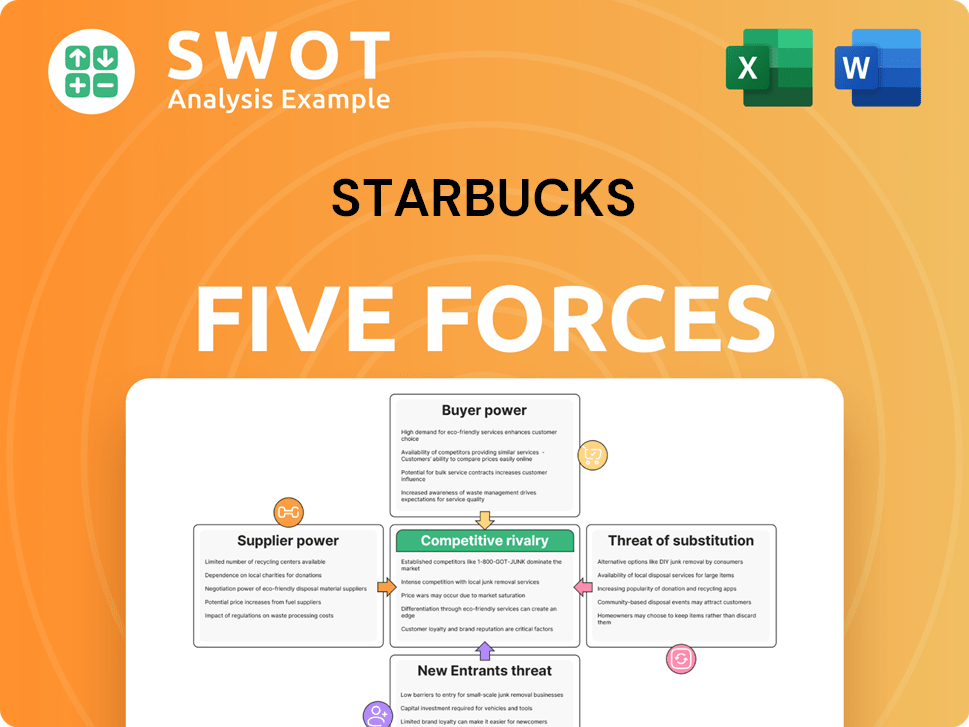
Related Blogs
- What are Mission Vision & Core Values of Starbucks Company?
- What is Growth Strategy and Future Prospects of Starbucks Company?
- How Does Starbucks Company Work?
- What is Sales and Marketing Strategy of Starbucks Company?
- What is Brief History of Starbucks Company?
- Who Owns Starbucks Company?
- What is Customer Demographics and Target Market of Starbucks Company?
Disclaimer
All information, articles, and product details provided on this website are for general informational and educational purposes only. We do not claim any ownership over, nor do we intend to infringe upon, any trademarks, copyrights, logos, brand names, or other intellectual property mentioned or depicted on this site. Such intellectual property remains the property of its respective owners, and any references here are made solely for identification or informational purposes, without implying any affiliation, endorsement, or partnership.
We make no representations or warranties, express or implied, regarding the accuracy, completeness, or suitability of any content or products presented. Nothing on this website should be construed as legal, tax, investment, financial, medical, or other professional advice. In addition, no part of this site—including articles or product references—constitutes a solicitation, recommendation, endorsement, advertisement, or offer to buy or sell any securities, franchises, or other financial instruments, particularly in jurisdictions where such activity would be unlawful.
All content is of a general nature and may not address the specific circumstances of any individual or entity. It is not a substitute for professional advice or services. Any actions you take based on the information provided here are strictly at your own risk. You accept full responsibility for any decisions or outcomes arising from your use of this website and agree to release us from any liability in connection with your use of, or reliance upon, the content or products found herein.